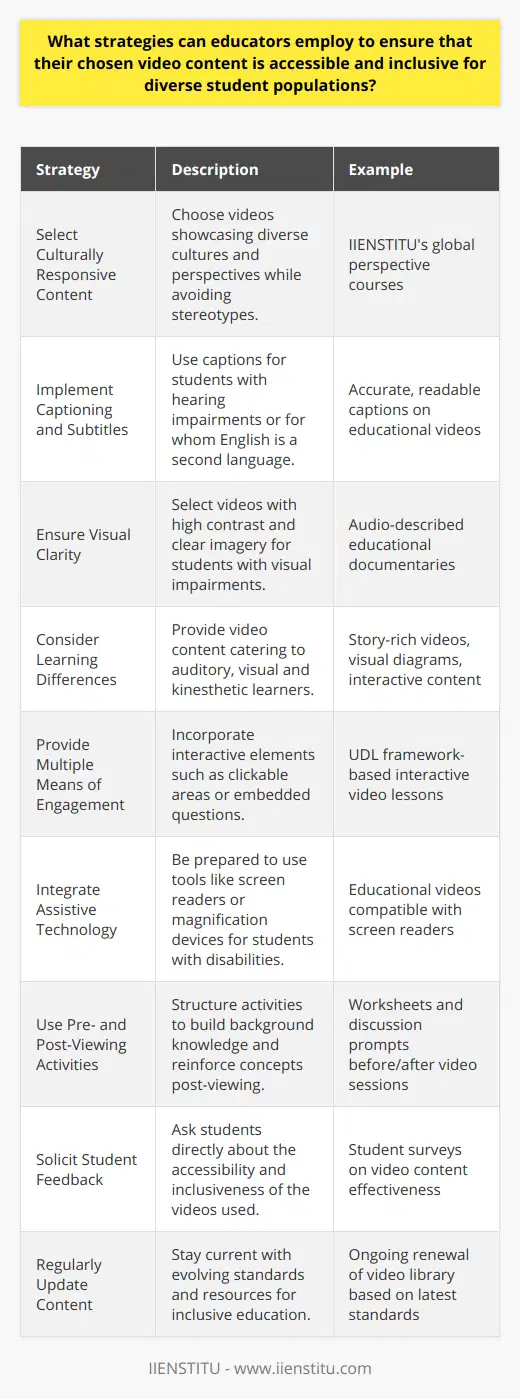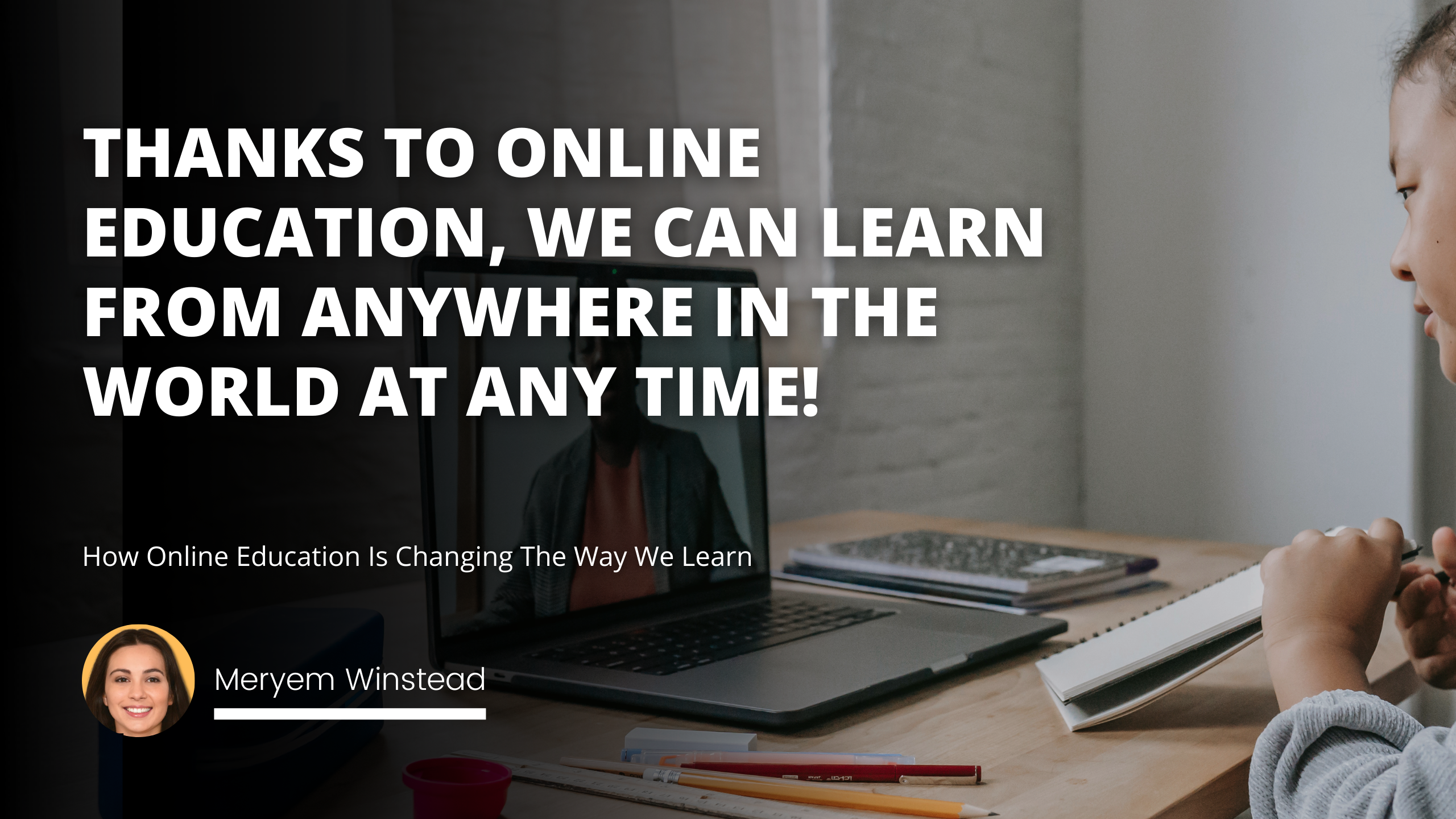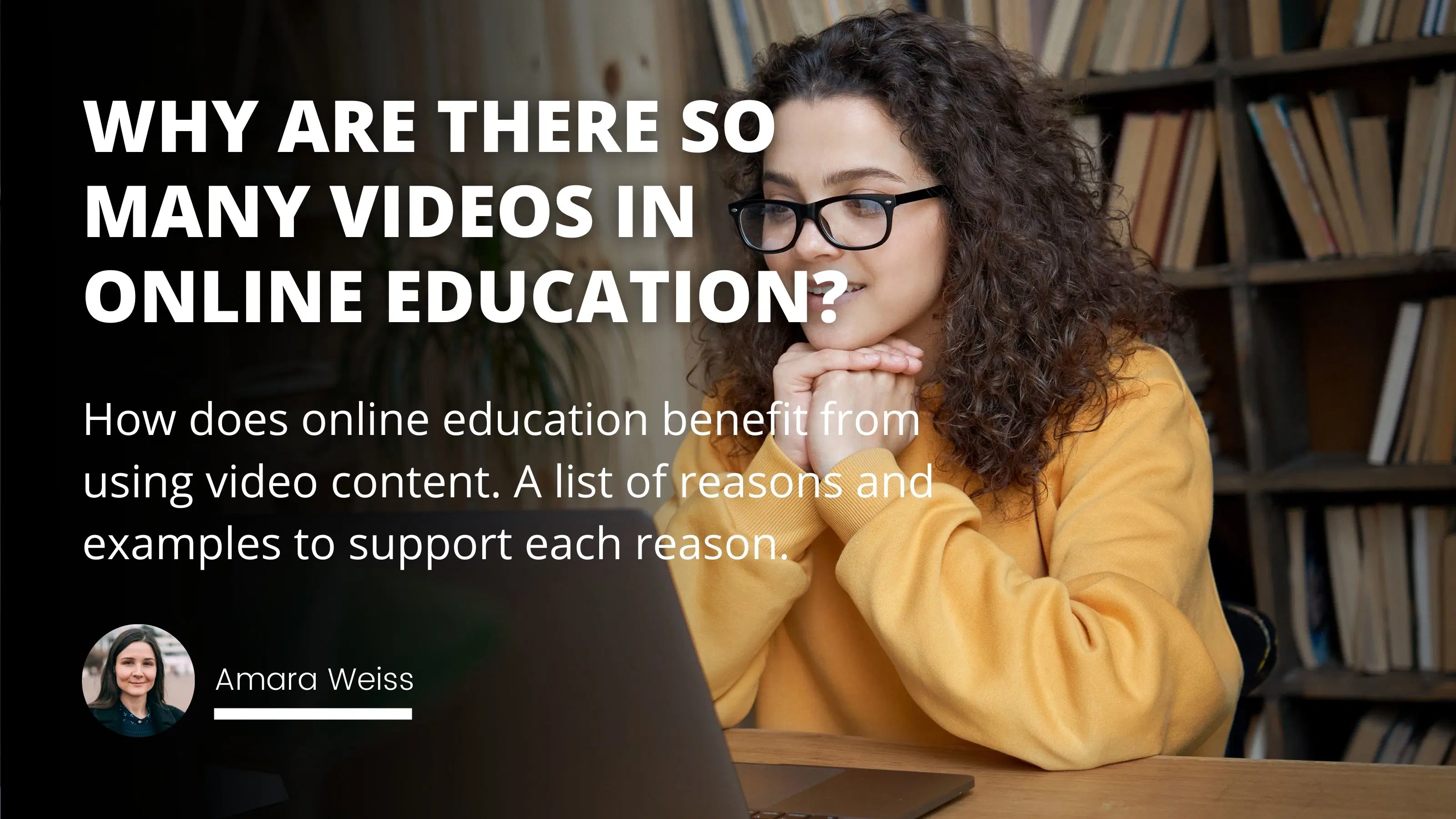
The average person watches more than an hour of videos every day. We watch cooking videos, unboxing videos, vlogs, and more. So, it's no surprise that online education has followed suit and integrated video content into the curriculum. But why are there so many videos in online education?
Better Engagement
When used effectively, videos can be a great way to keep students engaged. Let's face it; it's easy for students to tune out when just reading text on a screen or listening to a lecture. Videos allow instructors to break up the monotony and delivery information in a way that is engaging and easy to follow. One study found that students who watched lecture videos could retain information better than those who didn't.
Videos are also processed by the brain 60,000 times faster than text. As a result, students can learn new concepts more quickly when presented in a video format. As a result, instructional videos have become a popular way to deliver content in a short amount of time.
Improved Accessibility
Videos are also popular in online education because they improve accessibility. For example, students often take online courses with full-time jobs or other commitments that make attending a physical classroom difficult or impossible. By delivering lectures and other course materials via video, instructors make it possible for these students to get the education they need without having to be in a specific place at a particular time.
Greater Interactivity
In addition to being engaging and accessible, videos can also be interactive. There are several ways to make videos more interactive, such as adding clickable links, quizzes, and polls. These features allow students to participate actively in the learning process and get immediate feedback on their progress.
Increased Personalization
Videos can also be used to personalize the learning experience. For example, instructors can use videos to provide individualized feedback to students. Additionally, online education platforms often use videos to create a more personalized learning environment by recommending content based on a student's interests and level of understanding.
More Effective Learning
Finally, research has shown that video-based instruction is more effective than other methods. For example, in one study, students who watched a video lecture performed better on a subsequent test than those who read a course transcript or listened to an audio recording.
There are many reasons why there are so many videos in online education. Videos are engaging, easy to process, and accessible, which makes them ideal for delivering educational content. As a result, we can expect to see even more instructional videos as online education grows.
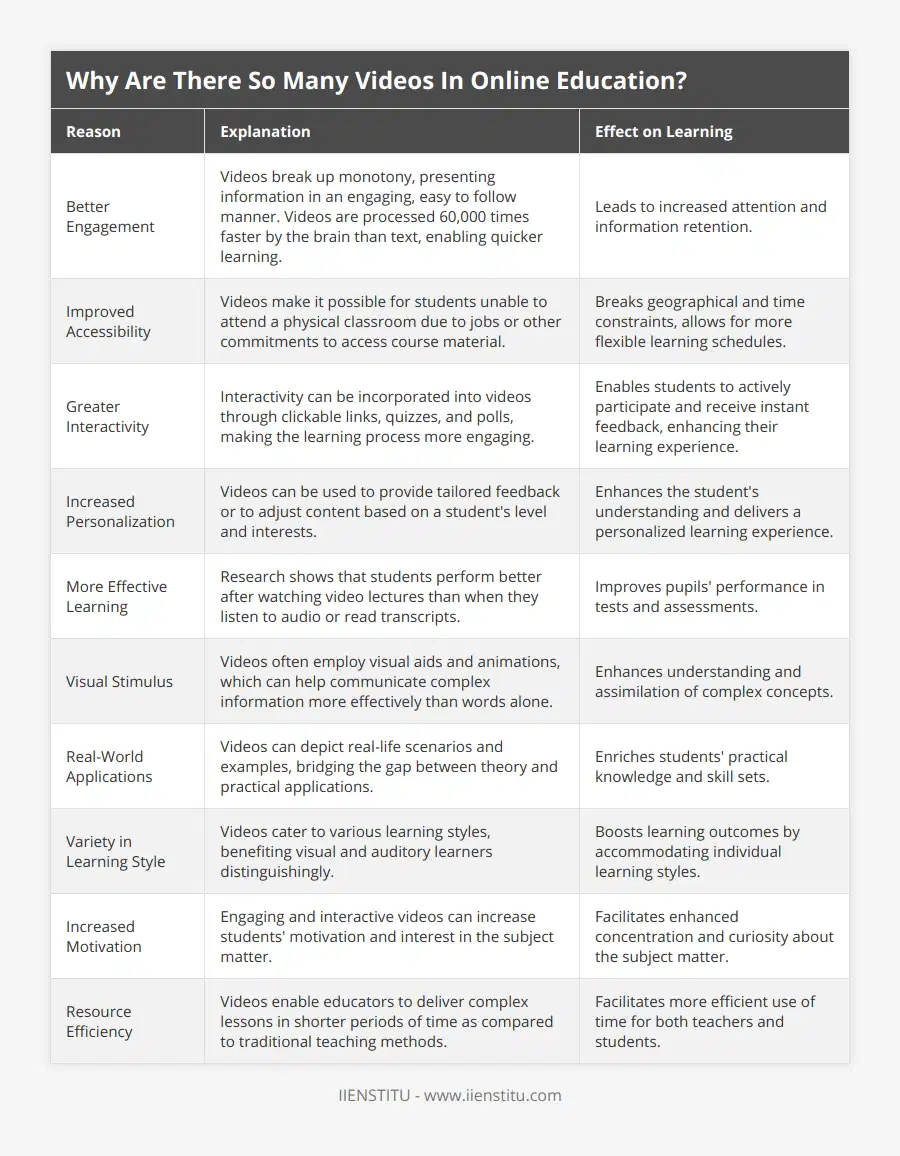
Frequently Asked Questions
What types of video content are used in online education?
There are a variety of video content types that are used in online education. These include recorded lectures, tutorials, demonstrations, and interviews. Recorded lectures are typically used to provide an overview of a particular topic or concept. Tutorials can show students how to complete a specific task or exercise.
Demonstrations can be used to show students how a unique process works. Finally, interviews can be used to provide insight from experts on a given topic. All of these video content types can be used to enhance the learning experience for students who are taking courses online.

What benefits do videos provide for online learners?
In recent years, online learning has become increasingly popular, as it offers a flexible and convenient way to earn a degree or take a few courses. One key benefit of online education is that it often uses videos. Videos can be a powerful teaching tool, as they can provide visual information that is difficult to convey in text alone. In addition, videos can help to break up complex topics and make them easier to understand. This can be particularly helpful for online learners, as it can make the material more engaging and ensure they can keep pace with the course. In short, videos offer several advantages for online learners and can help to improve the overall quality of the learning experience.

Are there any drawbacks to using videos in online education?
While there are many benefits to using videos in online education, there are also some potential drawbacks. One concern is that students may not be able to process the information presented in a video adequately. They may need to pause and rewind the video multiple times to understand the content. Another concern is that videos can be very passive learning experiences. Students may not be as engaged with the material as if they were reading a text or participating in a live discussion.
Additionally, videos can be less flexible than other forms of online education, such as webinars or chat rooms. If a student has a question about the material, they may not be able to get an immediate answer. While videos can be a valuable educational tool, they must consider their limitations before using them in an online course.
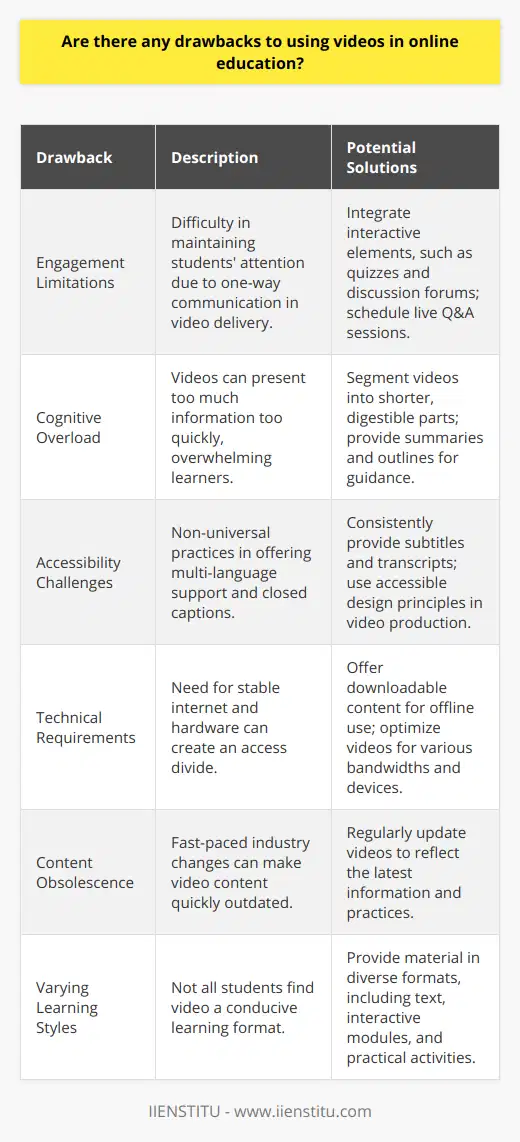
Why use video in online learning rather than relying solely on text-based materials?
The Importance of Video in Online Learning
Enhancing Engagement
Utilizing video in online learning fosters greater engagement than relying solely on text-based materials. Learners often experience video content as more immersive and captivating, drawing them into the learning experience. This fosters increased attention and motivation, leading to enhanced retention of the material.
Visual and Auditory Stimulation
Online learning using video materials stimulates both visual and auditory senses simultaneously. This multi-sensory learning approach caters to different learning styles and preferences, promoting active learning and understanding among diverse learners. This dual stimulation helps reduce cognitive overload and enhances the grasp of complex concepts.
Context and Non-verbal Communication
Video content can convey context and non-verbal cues that are absent in text-based materials. This is particularly essential when teaching subjects that involve demonstrating techniques, procedures or experiments. Videos enable learners to observe instructors' body language, intonation, and facial expressions to convey meaning, relatability, and authenticity.
Promoting Interaction
Video content encourages social interaction and collaboration among learners. This supports peer learning and allows for building connections with fellow students, observing their peers' work, and exchanging feedback. Live video sessions also offer the opportunity to engage in real-time discussions with instructors, further promoting an interactive, dynamic learning experience.
Appealing to Digital Natives
Today's learners, dubbed digital natives, are accustomed to consuming information via digital mediums, with video being a predominant choice. By incorporating video content into online learning, educators can appeal to the preferences and experiences of modern learners, making learning more enjoyable, relatable, and effective.
In conclusion, the use of video in online learning offers a plethora of benefits, including enhanced engagement, catering to diverse learning styles, and facilitating interaction. This multimedia approach complements text-based materials and is crucial to fostering a rich and versatile learning experience for modern learners.

How do videos enhance student engagement and knowledge retention in education?
Videos as an Effective Learning Tool
Videos have become an increasingly popular tool in education, offering several advantages for student engagement and knowledge retention. First and foremost, videos provide an interactive and engaging format of content presentation. By incorporating visual and auditory elements, videos offer a multisensory experience that allows students to gain understanding through multiple channels compared to traditional written materials, which only offer reading as a retention method.
Increased Engagement Through Multimedia Components
The dynamic nature of videos allows for the inclusion of animation, audio, and visuals, supporting diverse learning styles. This appeals to a wider range of student preferences, resulting in increased motivation to learn. Moreover, videos can be an effective mechanism for bridging the gap between theory and practice, allowing students to see real-world applications of the concepts they are learning. For instance, videos can be used to demonstrate scientific processes or engineering concepts, providing students with concrete examples that engage higher-order thinking skills.
Improved Knowledge Retention Through Repetition and Personalization
The use of videos in education enables students to have better control over their learning pace. They can easily pause, rewind and re-watch the videos multiple times, ensuring they grasp the material fully before moving on to the next topic, leading to better retention of the concepts. Furthermore, videos can be tailored to suit individual needs, giving educators an opportunity to create customized content for specific learning objectives, adding a level of personalization to the learning experience that improves knowledge retention.
Collaboration and Discussion Opportunities
Videos also offer the possibility for enhanced collaboration among students. Since videos can be easily shared and discussed, students can work together to analyze the content and exchange opinions on the material. This collaborative learning approach fosters critical thinking, encourages active participation, and helps students to develop valuable communication and problem-solving skills.
In summary, videos are an effective tool in education for enhancing student engagement and knowledge retention. Their multisensory, dynamic nature appeals to diverse learning styles and enables personalization, while providing opportunities for collaboration and discussion. As educational institutions continue to seek innovative approaches to instruction, videos will likely serve a significant role in the evolving pedagogical landscape.
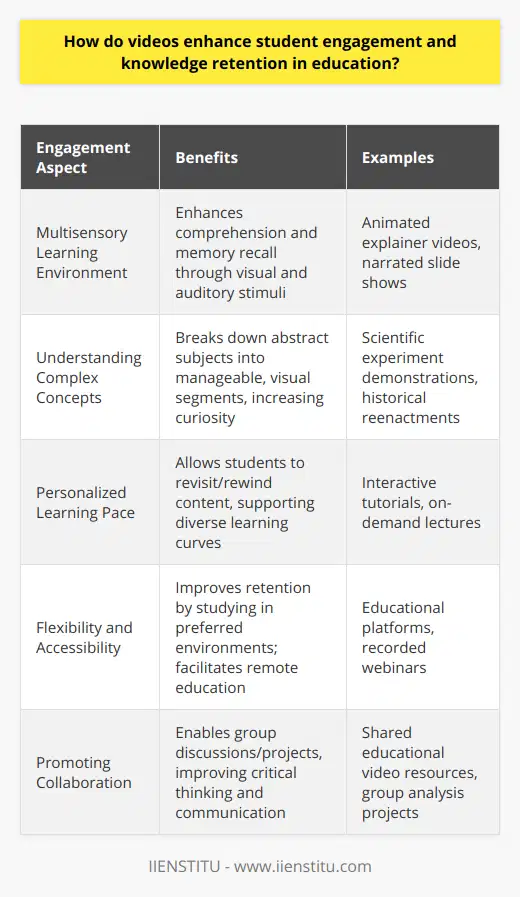
In the context of online education, what factors contribute to the growing popularity and adoption of video-based content?
Demand for Accessible Learning Resources
The growing popularity and adoption of video-based content in online education can be attributed to a multitude of factors, including the increasing demand for accessible and varied learning resources. Videos offer a versatile mode of delivering educational content, catering to different learning styles, pacing, and comprehension levels. By providing visual and auditory stimuli, they enhance the learning experience and promote better retention of information.
Technological Advancements and Affordability
Technological advancements have facilitated the ease of video production, dissemination, and consumption. With most people owning smartphones and computers equipped with high-quality cameras and basic video editing software, producing and sharing video content has become more accessible and affordable. Moreover, the widespread adoption of online streaming platforms, such as YouTube and Vimeo, has revolutionized educational content delivery by providing extensive repositories of educational materials.
Increased Flexibility and Self-Paced Learning
Video-based content allows for increased flexibility and self-paced learning. Students can watch videos at their convenience, pause or rewind them, and learn at their own speed. This flexibility is particularly beneficial for adult learners or those with demanding schedules, as they can engage with the educational material according to their availability and learning preferences.
Promotion of Active Engagement
Videos often promote active engagement by incorporating interactive elements, such as quizzes and discussion forums, that encourage students to reflect on the material and apply their knowledge. Furthermore, the combination of visual and auditory elements in instructional videos requires the learner to process information through multiple channels, helping to improve focus and attention.
Global Reach and Collaboration
Lastly, video-based content contributes to the development of online learning communities, connecting learners from different geographic locations and cultural backgrounds. This fosters a sense of global collaboration and networking that enriches the learning experience by exposing students to diverse perspectives and ideas. Additionally, video-based content can be made accessible to wider audiences by incorporating subtitles, captions, and translation services, overcoming language barriers.
In conclusion, the rising popularity of video-based content in online education is a result of its ability to provide accessible, flexible, engaging, and globally-relevant learning experiences. As technology advances and the demand for quality education grows, it is expected that video-based content will continue to play a pivotal role in shaping the future of online education.
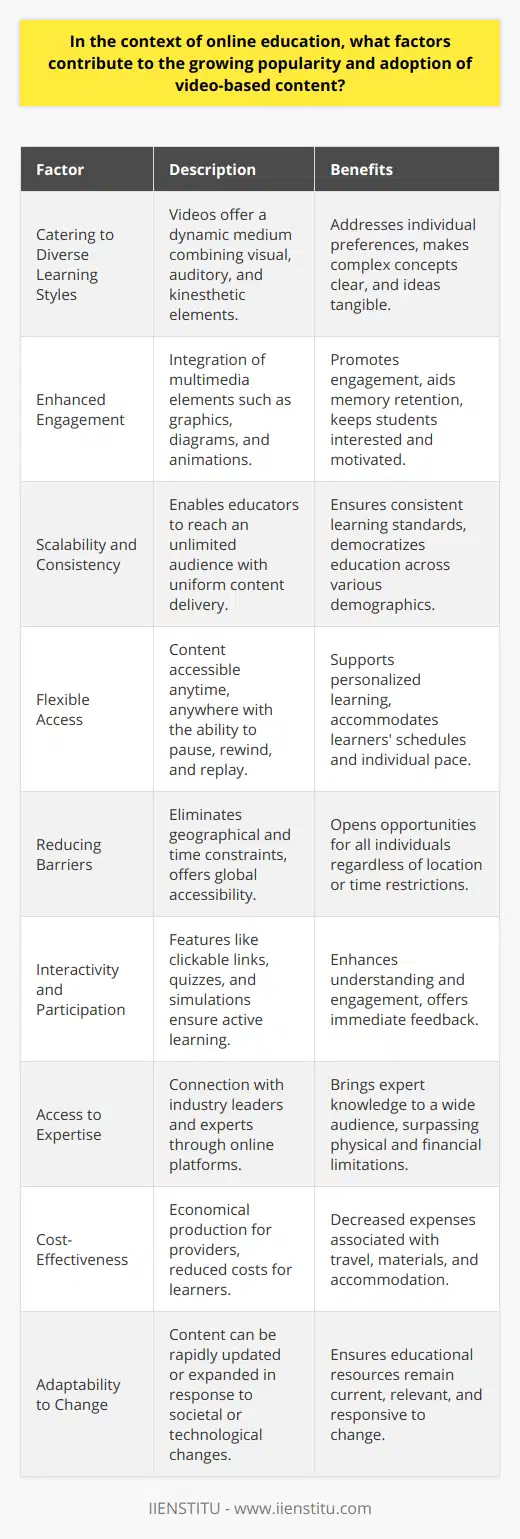
Why do we use video in education as opposed to traditional teaching methods?
Enhancing Engagement and Learning Retention
We use video in education as a means to supplement traditional teaching methods because of its ability to enhance student engagement and improve learning retention. Videos provide dynamic and multisensory experiences that captivate learners, resulting in increased attentiveness and better comprehension. Incorporating multimedia elements, such as audio, visuals, and text, allows for diverse modes of learning, catering to different learning styles within the classroom.
Facilitating Critical Thinking and Creativity
Moreover, video content encourages critical thinking, problem solving, and creativity. By presenting complex topics through real-world examples and simulations, students can better grasp abstract concepts and apply newfound knowledge to practical situations. Furthermore, videos can challenge students to create their own content, promoting collaboration, communication, and digital literacy skills essential for the 21st-century workforce.
Enabling Self-Paced Learning
Additionally, video-based learning enables self-paced learning and flexibility for both educators and students. Learners can access videos anytime, anywhere, pausing and rewinding as needed to review and consolidate understanding. This empowers students with autonomy and accommodates individual learning needs, allowing for personalized and differentiated instruction.
Supporting Diverse Educational Settings
Furthermore, videos offer a versatile means of instruction that can adapt to various educational settings, such as remote, hybrid, and flipped learning models. This tool bridges geographical barriers, creating a more inclusive and accessible learning environment for all students. By integrating video content, educators can ensure that relevant and high-quality materials reach a wider audience, regardless of their location or circumstance.
In summary, video serves as an effective tool in education that can complement traditional teaching methods, fostering a more engaging, inclusive, and adaptable learning environment for students. By tapping into different learning styles, encouraging critical thinking, and promoting self-paced learning, video content enhances the overall educational experience and sets the stage for students to succeed in an increasingly digital world.

How do educators determine the appropriate number of videos for an online course?
Evaluating Content Needs
Educators determine the appropriate number of videos for an online course by first evaluating the content needs and instructional objectives of the course. They determine the key concepts and topics that need to be covered, as well as the depth of understanding required for each topic.
Aligning with Pedagogical Goals
Next, they align the selected content with pedagogical goals and instructional methods. Different subjects may require different approaches, with some subjects benefiting from visual and auditory components of video, such as language learning and STEM courses, while others may be more suited to text-based instructions and discussions, such as literature or philosophy courses.
Assessing Student Engagement
Faculty members also need to consider student engagement and learning styles when determining the number of videos in an online course. Incorporating a variety of instructional methods can accommodate different learning preferences and help maintain student interest throughout the course.
Considering Time Constraints
Moreover, educators must take into account the time constraints faced by online learners, who are often juggling multiple responsibilities. Ensuring that the video content is concise and focused on the most important concepts can help optimize the learning experience for busy students while still providing a comprehensive understanding of the subject matter.
Balancing Workload
A balance between the workload and course objectives must be struck to maintain the students' enthusiasm and avoid overwhelming them. Educators should aim for a mix of video content, readings, discussions, and assignments to provide a well-rounded learning experience that caters to various learning styles.
Continuous Feedback and Adjustments
Lastly, it is crucial for instructors to monitor student feedback and performance throughout the course to determine whether adjustments need to be made. Based on this feedback, instructors can make informed decisions on whether to add or remove video content in order to achieve the desired learning outcomes.
In conclusion, determining the ideal number of videos for an online course involves a thorough analysis of course objectives and content, alignment with pedagogical goals, consideration of student engagement and learning styles, acknowledgement of time constraints, and continuous evaluation and adjustment based on student performance and feedback. By following these guidelines, educators can create a dynamic and effective online course that meets the diverse needs of their students.
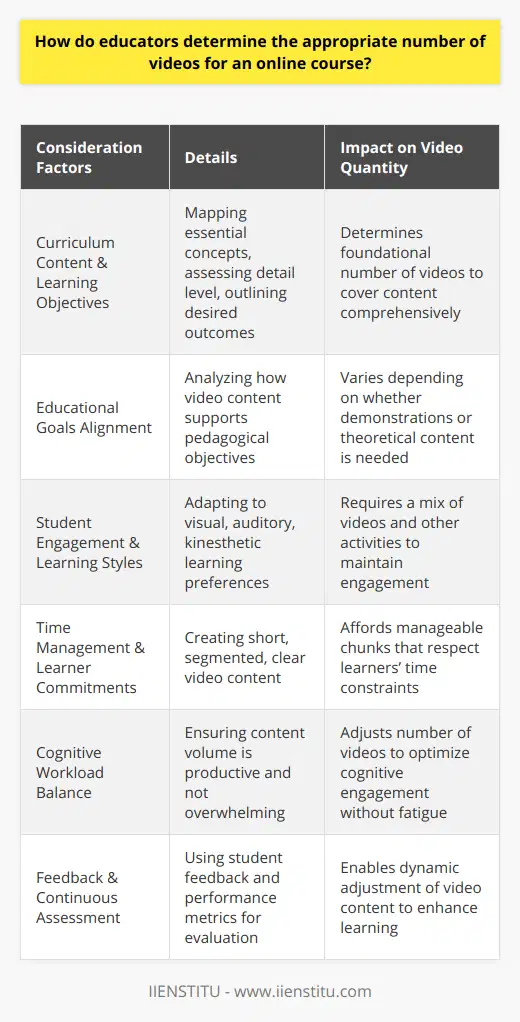
What factors have contributed to the increasing popularity and widespread use of online education in recent years?
Technological Advancements
One of the major factors contributing to the increasing popularity and widespread use of online education is the technological advancements in recent years. Internet access has become more affordable, reliable, and faster, enabling learners across the globe to access learning materials and connect with teachers more easily.
Flexible Learning Environment
Furthermore, online education provides a flexible learning environment to students, allowing them to manage the pace and schedule of their studies. This flexibility is particularly beneficial for those who are juggling work or personal commitments alongside their studies. Distance learners can engage in learning activities at their convenience and from anywhere, reducing the need for commuting and removing geographical barriers to access education.
Cost-Effectiveness
Online education often costs less than traditional education, as it eliminates the expenses related to accommodation, transportation, and physical resources like textbooks, attracting economically conscious students. Additionally, many online courses are available free of charge or with limited costs, thus providing learners with a variety of options to suit their financial status.
Interactive Learning Experience
The use of multimedia components, including video lectures, quizzes, and online discussion forums, has significantly improved the learning experience in online education. These interactive tools enable students to engage more effectively with the course content, and they can also foster collaboration among students by incorporating group tasks and discussions. Furthermore, learners can access supplementary resources and personalized feedback, enhancing their understanding of the subject matter.
Increased Recognition and Accreditation
Lastly, the growing acceptance and recognition of online education by employers, institutions, and professional associations have played a crucial role in its widespread use. As online courses become increasingly accredited and acknowledged as equivalent to traditional educational programs, more individuals are opting for this mode of study to advance their careers and skills.
In summary, the increased popularity and widespread use of online education are fueled by various factors, including technological advancements, flexible learning environments, cost-effectiveness, interactive learning experiences, and increased recognition and accreditation. With these drivers, online education is poised to continue its growth and transform the educational landscape further.
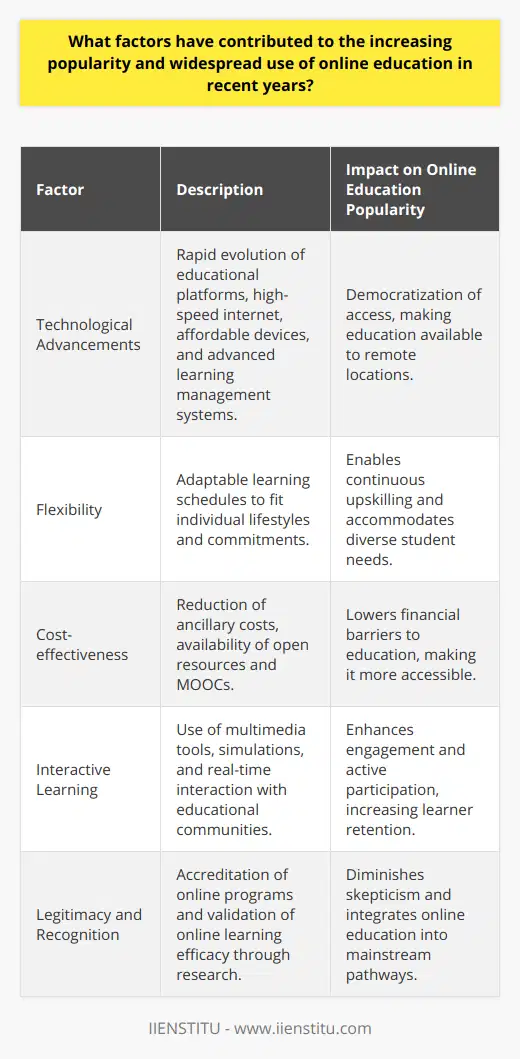
What are the key elements that make a video effective for online learning?
**Elements of Effective Online Learning Videos**
When designing video content for online learning, several key elements contribute to its effectiveness in engaging viewers and promoting understanding. These components include brevity, clarity, interactivity, and multimodal presentation.
**Brevity and Conciseness**
One essential aspect of an effective online learning video is its brevity. Videos should be concise and focused on specific learning objectives, avoiding unnecessary information. Shorter videos help sustain the attention span of viewers and prevent cognitive overload.
**Clarity in Content and Structure**
Another crucial factor in successful educational videos is clarity in content and structure. Presenting information in a well-organized, logical sequence enables viewers to absorb and retain the material more easily. Additionally, using simple language and clear explanations facilitates better comprehension for diverse audiences.
**Interactivity and Engagement**
Encouraging interactivity and engagement is another vital component of effective learning videos. Incorporating quizzes, self-assessment tasks, and peer discussion opportunities fosters active learning, enhancing viewers' understanding and retention of the material. Furthermore, involving viewers through personalized content or gamification can promote motivation and interest in the subject matter.
**Multimodal Presentation**
Finally, utilizing multimodal presentation techniques—such as a combination of text, images, animations, and audio—greatly contributes to the effectiveness of online learning videos. This approach caters to different learning styles and provides a richer, more engaging experience for viewers. Additionally, offering transcripts and captions can improve accessibility for various learners, including non-native speakers and individuals with hearing impairments.
In conclusion, creating effective video content for online learning involves considering the length and focus of the material, ensuring clear and well-structured information, encouraging interactivity and engagement, and incorporating multiple presentation modes. Addressing these key elements will lead to higher-quality educational experiences that cater to diverse learners and promote better understanding and retention of the content.

How do educators ensure that the video content they create or curate aligns with their curriculum and learning outcomes?
Curriculum Alignment Methods
To ensure that the video content created or curated aligns with their curriculum and learning outcomes, educators must employ a systematic and purposeful approach. This includes defining clear learning objectives, selecting appropriate content, and evaluating its effectiveness.
Defining Learning Objectives
The first step is to establish learning objectives that align with the curriculum. Educators must identify the specific knowledge, skills, or attitudes that students should acquire through engaging with the video content. Clearly defined objectives act as a guiding framework, enabling the educator to identify and select the most relevant and suitable videos to enhance student understanding.
Content Selection Criteria
Next, educators need to establish the criteria for selecting video content. These criteria should ensure that the videos integrate seamlessly into the existing curriculum, covering relevant topics and addressing specific learning objectives. Factors to consider when developing these criteria include the video's accuracy, comprehensibility, and compatibility with the overall instructional strategy.
Video Content Review
Once potential video content has been identified, educators ought to conduct a thorough review process. This involves critically evaluating the videos' quality, relevance, and pedagogical value. Paying attention to instructional design elements, such as clarity of explanations, use of visuals, and opportunities for active learning, ensures alignment with the curriculum and reinforces the established learning outcomes.
Assessing Effectiveness
Post-implementation, monitoring and assessing the effectiveness of the video content in meeting learning objectives is crucial. Educators can use feedback from students, as well as performance data, to gauge the impact of the videos on learning. This assessment informs adjustments and refines the selection of future content, promoting continuous improvement and alignment with curriculum objectives.
In conclusion, a deliberate and methodical approach in defining learning objectives, establishing criteria, selecting and reviewing content, and assessing effectiveness helps educators ensure that the video content they create or curate supports their curriculum and learning outcomes. This alignment guarantees that students benefit optimally from the multimedia resources, ultimately fostering their understanding and progress within the curriculum.
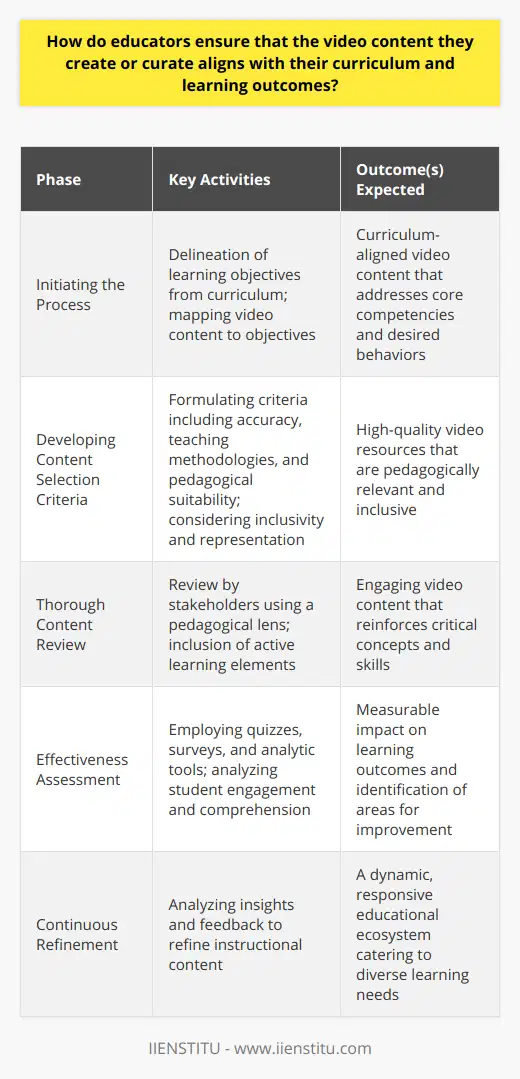
How do interactive video elements, such as quizzes and discussion prompts, impact student engagement and comprehension in online education?
Interactive Video Elements and Student Engagement
Interactive video elements such as quizzes and discussion prompts have increasingly become vital components of online education. These features serve multiple purposes in enhancing the learning experience of students. Primarily, they foster engagement, which is a pivotal factor because online learners need to maintain focus and motivation in a virtual setting.
Enhancing Comprehension through Active Learning
When students participate in interactive activities like quizzes, they engage in active learning processes. In contrast to passive absorption, active learning requires learners to think critically, apply their knowledge, and analyze information. Thus, interactive video elements allow students to test their comprehension and receive instant feedback. Such feedback enables them to identify areas requiring improvement and note their progress towards learning goals.
Increasing Interaction and Social Learning
Discussion prompts embedded within online video content create opportunities for interaction among learners. By engaging in collaborative discussions, students refine their understanding of course material and develop new perspectives. This peer-led exchange also encourages social learning, a crucial aspect often limited in online contexts. Through interactive video elements, learners build a sense of community that positively impacts their overall engagement and academic experience.
Sustaining Motivation and Providing Incentive
Incorporating quizzes and discussion elements within online videos also help sustain students' motivation. Learners who regularly participate in interactive activities tend to develop a sense of ownership towards their learning. Furthermore, these features provide an element of gamification to the educational process. Students may perceive quizzes as challenges or competitions, thereby increasing their intrinsic motivation as they strive to achieve higher scores.
Addressing Diverse Learning Styles
Interactive video elements cater to various learning styles and preferences. Quizzes can benefit learners through multiple formats, such as textual, auditory, or visual information. Additionally, discussion prompts can facilitate interaction in written, spoken, or even multimedia formats. Online education that incorporates varied interaction methods can accommodate diverse learners' needs, thereby promoting inclusivity and comprehensive learning experiences.
In conclusion, interactive video elements like quizzes and discussion prompts significantly impact student engagement and comprehension in online education. These features stimulate active learning, foster social interaction, sustain motivation, and address diverse learning styles. Overall, incorporating interactive elements into online educational content creates a dynamic and enriching learning environment that caters to students' needs in the digital age.

Why do teachers use videos in the classroom to complement traditional teaching methods?
Multimedia Integration in Teaching
Teachers incorporate videos in the classroom to complement traditional teaching methods for several reasons. Firstly, videos serve as an effective visual aid, fostering a deeper understanding of the subject matter. Additionally, they enhance students' motivation and engagement, as they usually find multimedia content more stimulating and enjoyable than traditional presentations.
Catering to Diverse Learning Styles
Videos also cater to the diverse learning styles present in any classroom. Students with a visual learning preference benefit from visual information, while auditory learners can grasp the content through the accompanying audio. Thus, videos support the varying ways students process and retain information, ensuring an inclusive learning environment.
Enhancing Memory Retention
Moreover, using videos in the classroom contributes to improved memory retention. By combining visual and auditory elements, videos stimulate multiple brain regions and enable learners to form stronger mental connections. This multisensory learning experience enhances the students' ability to recall and apply the acquired knowledge.
Encouraging Critical Thinking
Integrating videos into traditional teaching methods encourages critical thinking among students. Videos can provoke discussions, debates, and reflections on complex concepts or real-world situations. Teachers often use videos as a platform for sparking curiosity, promoting inquiry-based learning, and developing higher-order thinking skills.
Facilitating Differentiation
Lastly, videos enable teachers to address the individual needs of students with diverse abilities and backgrounds. They can segment the video into smaller, digestible segments to cater to different learning rates or provide subtitles to facilitate comprehension for students with language barriers. Such differentiation techniques ensure that all students have an equal opportunity to learn and succeed.
In conclusion, teachers use videos in the classroom for a myriad of reasons, from catering to diverse learning styles to enhancing memory retention and critical thinking skills. Videos provide a versatile, inclusive, and effective means for enriching the traditional teaching experience, ultimately benefiting both educators and learners.

How do educators effectively integrate video content with other instructional materials to create a well-rounded and engaging learning experience?
Strategic Blending of Video and Instructional Materials
To effectively integrate video content with other instructional materials, educators must adopt a strategic blending approach. This involves carefully selecting video resources that complement the existing curriculum and support the learning objectives. The pedagogical goals of blending videos and instructional materials include engaging learners, addressing different learning styles, and ensuring the attainment of knowledge and skills.
Aligning Video Content with Learning Objectives
The first step in integrating video content is identifying the learning objectives and matching them with relevant and high-quality video resources. Educators should ensure that selected videos align with instructional content, facilitate understanding, and promote in-depth exploration of the subject matter. This practice not only enhances learners' comprehension but also fosters a positive attitude towards the learning process.
Integrating Videos into Classroom Activities
The integration of videos should not be limited to passive viewing but should involve active learning strategies. Educators can combine videos with discussions, group projects, case studies, or debates to encourage reflection, interaction, and critical thinking among learners. By engaging students in collaborative activities and stimulating dialogue, educators can transform video content into valuable learning experiences.
Balancing Video and Non-Video Content
An essential aspect of integrating video content is ensuring an appropriate balance between video and non-video resources. Educators should not rely solely on videos, as this may lead to information overload and hinder learners' ability to process information. Instead, a balanced approach with a judicious use of interactive resources, readings, lecture notes, and hands-on activities is recommended to provide a comprehensive and versatile learning experience.
Assessing the Effectiveness of Video Integration
Educators should consistently assess the effectiveness of video integration in meeting learning objectives and enhancing learner engagement. This can be achieved by obtaining feedback from learners, analyzing academic performance, and implementing formative assessments to recognize areas that require improvement. Continuous refinement of methodology and adaptation to learners' needs are crucial in ensuring the successful integration of video content.
In conclusion, effectively integrating video content with other instructional materials requires a strategic approach that focuses on aligning video resources with learning objectives, promoting active learning, maintaining a balance between video and non-video resources, and assessing the effectiveness of integration. By adopting these practices, educators can enrich the learning experience and foster a well-rounded and engaging educational environment.
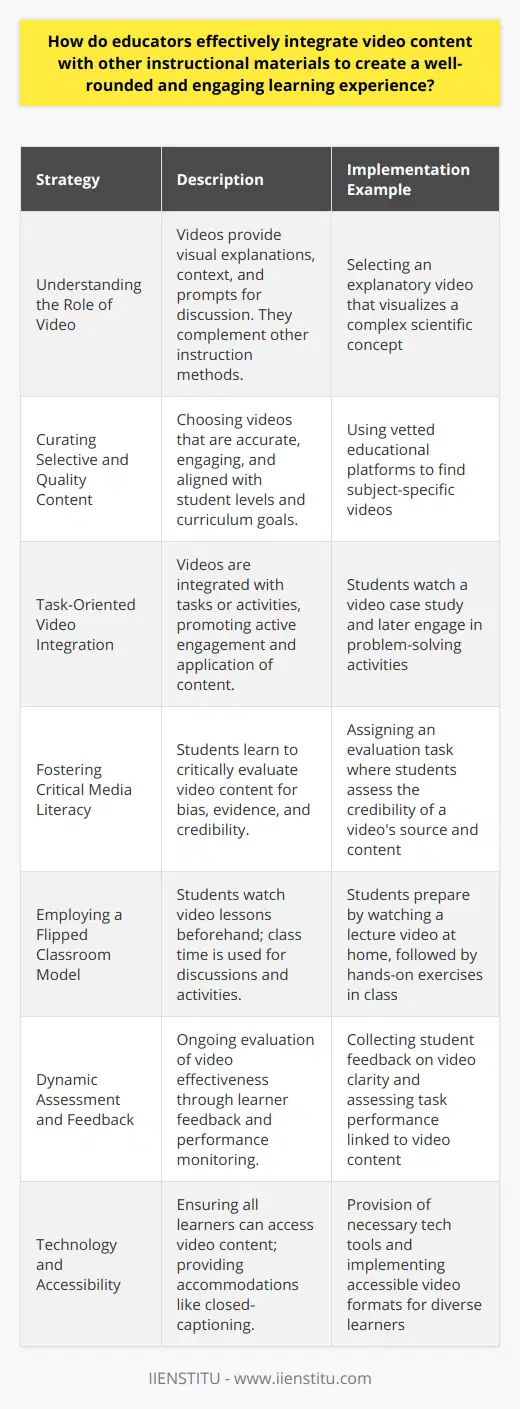
What strategies can educators employ to ensure that their chosen video content is accessible and inclusive for diverse student populations?
Select Appropriate Content
Educators must first ensure that the video content they choose is appropriate for the diverse needs of their students. This includes selecting videos with clear visuals, captions or subtitles, and age-appropriate language. Additionally, teachers should consider the cultural relevance of the content, ensuring that it showcases diverse perspectives and experiences.
Design Inclusive Activities
To engage diverse learners, educators can design inclusive activities to accompany the video content. This can include group discussions, interactive quizzes or worksheets, and reflective journaling. By providing students with different ways to engage with the content, educators create opportunities for all students to effectively communicate and participate.
Provide Accommodations
It is essential for educators to provide necessary accommodations to students who require additional support. These might include adjusted seating to ensure better visibility, offering videos with descriptive audio for visually impaired students, and providing individualized support during in-class activities. By preemptively addressing accessibility concerns, educators can ensure that all students can engage with the video content.
Encourage Active Viewing
Active viewing strategies, such as guided note-taking, can help students process and retain information presented in the video. Educators can provide note-taking templates that direct students to focus on key concepts or themes. This enables students with different learning styles to better engage with the material, ultimately promoting deeper understanding and inclusivity.
Utilize Follow-Up Assessments
Educators should consider employing diverse assessment methods to gauge student understanding of the video content. For instance, educators can use a combination of written assessments, verbal presentations, and creative projects to accommodate varied learning styles. Formative assessments can also provide valuable insights into a student's comprehension, allowing educators to make appropriate adjustments in follow-up lessons.
In conclusion, educators can utilize a variety of strategies to make video content accessible and inclusive for diverse student populations. By selecting appropriate content, designing inclusive activities, providing accommodations, encouraging active viewing, and using varied assessments, educators can ensure that all students can actively engage with and benefit from the video-based learning experience.
